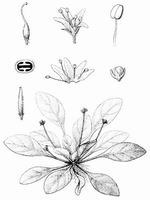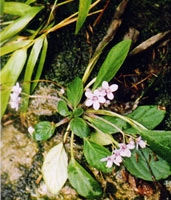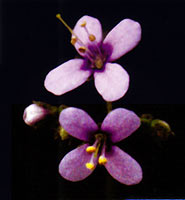
Ying T.S. et al., The endemic genera of seed plants in China, Fig. 127 (1993); with permission.
Full name and orig. publication: Thamnocharis W.T.Wang, Acta Phytotax. Sinica 19: 485 (Nov. 1981).
Etymology: From the Greek θαμνος, thamnos = shrub, bush, and -χαρις, -charis = loving, friend of, fond of. The name means that the plant likes to grow in shrubbery.
Synonyms: -
Infrafamilial position: Didymocarpoid Gesneriaceae - "Advanced Asiatic and Malesian genera" (Weber 2004).
Description: Perennial rosette herbs with short vertical rhizome. Leaves radial, petiolate, lamina elliptic, lanceolate or narrowly obovate, base cuneate, margin obscurely serrate, densely white puberulous on both surfaces. Cymes long-pedunculate, with two subulate bracteoles and 5 to 9 small flowers. Calyx, corolla and androecium 4- or 5-merous. Sepals free, narrow triangular. Corolla purple or blue, with very short tube, lobes 4 or 5, lanceolate-oblong, of equal size and shape. Stamens 4 or 5 of unequal length, alternate with corolla lobes; filaments linear; anthers basifixed, locules parallel, not confluent at apex. Nectary annular. Ovary ovoid, puberulous; style slender, glabrous; stigma truncate. Capsule cylindrical, sparsely strigose, loculicidally dehiscent.
Chromosome number: Unknown.
Type and only species: Thamnocharis esquirolii (H. Lev.) W.T. Wang
Distribution: S China (SW Guizhou).
Ecology: Growing in forests and thickets, 1500-1600m.
Selected references: Wang et al. in Wu & Raven (eds.), Fl. China 18: 249 (1998).
Bibliography: See Skog, L.E. & J.K. Boggan. 2005. Bibliography of the Gesneriaceae. 2nd edition: http://persoon.si.edu/Gesneriaceae/Bibliography.
Illustrations:
 |
Thamnocharis esquirolii (H.LÚv.) W.T.Wang, type and only species
Ying T.S. et al., The endemic genera of seed plants in China, Fig. 127 (1993); with permission. |

|

|
Thamnocharis esquirolii (H.Lev.) W.T.Wang, only species Li Z.Y. & Wang Y.Z., Plants of Gesneriaceae in China, Fig. 1.1 and 1.2 (2004); with permission. |
last modified: 2007-07-13